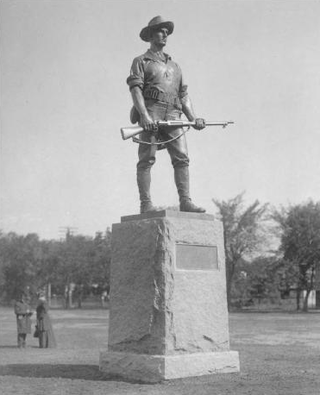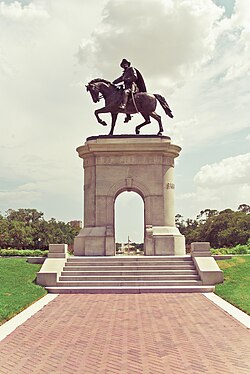
Pompeo Luigi Coppini was an Italian born sculptor who emigrated to the United States. Although his works can be found in Italy, Mexico and a number of U.S. states, the majority of his work can be found in Texas. He is particularly famous for the Alamo Plaza work, Spirit of Sacrifice, a.k.a. The Alamo Cenotaph, as well as numerous statues honoring Texan figures.

Brevet Lt. General Winfield Scott is an equestrian statue in Washington, D.C., that honors career military officer Winfield Scott. The monument stands in the center of Scott Circle, a traffic circle and small park at the convergence of 16th Street, Massachusetts Avenue and Rhode Island Avenue NW. The statue was sculpted by Henry Kirke Brown, whose best-known works include statues of George Washington in New York and Nathanael Greene in Washington, D.C. It was the first of many sculptures honoring Civil War generals that were installed in Washington, D.C.'s traffic circles and squares and was the second statue in the city to honor Scott.

The Hiker is a statue created by Theo Alice Ruggles Kitson. It commemorates the American soldiers who fought in the Spanish–American War, the Boxer Rebellion and the Philippine–American War. The first version of it was made for the University of Minnesota in 1906, but at least 50 copies were made, and were erected widely across the United States.

Theodore Roosevelt, Rough Rider is a toppled bronze sculpture, not currently restored, by American artist Alexander Phimister Proctor, formerly located in the South Park Blocks of Portland, Oregon in the United States. The equestrian statue was completed in 1922 and depicts Theodore Roosevelt as the leader of the cavalry regiment that fought during the Spanish–American War called the Rough Riders.

The Promised Land is an outdoor bronze sculpture by David Manuel, de-accessioned in 2020, formerly located in Chapman Square, in Portland, Oregon.

A 1926–27 statue of George Washington by Italian American artist Pompeo Coppini, sometimes called George Washington, was installed in northeast Portland, Oregon, United States. The bronze sculpture was the second of three statues of Washington by the artist, following a similar statue installed in Mexico City in 1912 and preceding another installed on the University of Texas at Austin campus in February 1955. The Portland statue was created to commemorate the 1926 sesquicentennial of the Declaration of Independence and dedicated in 1927. It was part of the City of Portland and Multnomah County Public Art Collection courtesy of the Regional Arts & Culture Council. In June 2020, it was toppled by protestors.

Thomas Jefferson is a 1911 bronze statue of a seated Thomas Jefferson created by Karl Bitter for the Cuyahoga County Courthouse in Cleveland, Ohio, United States.

Benito Juarez is one of two sculptures of the Mexican president of the same name, created by Julian Martinez. One full-length statue is installed in Chicago, in the U.S. state of Illinois, and another bust is installed in Hermann Park's McGovern Centennial Gardens, in Houston, Texas. The Chicago statue replaces a previously installed bust.
An outdoor 2007 bronze sculpture of Martin Luther King Jr. by American artist Ed Dwight is installed in Hermann Park's McGovern Centennial Gardens in Houston, Texas, United States. The sculpture was vandalized with white paint in August 2017. John D. Harden, Margaret Kadifa, Mike Morris, and Brooke A. Lewis of the Houston Chronicle noted that the vandalism occurred around the same time that protesters demanded the removal of Confederate monuments and memorials in Houston, and the same day that the city's statue of Christopher Columbus was vandalized with red paint.

Joan of Arc, also known as Joan of Arc, Maiden of Orleans, is an outdoor copy of Emmanuel Frémiet's equestrian statue Jeanne d'Arc (1874), installed in Portland, Oregon's Laurelhurst neighborhood, in the United States. The bronze sculpture, which depicts Joan of Arc, was donated to the city by Henry Waldo Coe, who saw Frémiet's original statue in Paris. Portland's copy arrived from France in 1924 and was dedicated on Memorial Day in 1925 in honor of the Doughboys of World War I.

El Cid Campeador is an outdoor equestrian statue depicting the Spanish knight El Cid by artist Anna Hyatt Huntington, architect William Templeton Johnson, and the foundry General Bronze Company, installed at Balboa Park's Plaza de Panama, in San Diego, California. The bronze sculpture was created in 1927 and dedicated on July 5, 1930. The statue measures approximately 11 x 9 x 7 ft, with a 16-foot diameter, and its concrete or Indiana limestone base measures approximately 11 x 14 x 8 ft. It was surveyed and deemed "treatment needed" by the Smithsonian Institution's "Save Outdoor Sculpture!" program in March 1994.

Dick Dowling is a 1905 marble sculpture of Confederate commander Richard W. Dowling by Frank Teich, previously installed in 1958 at the Cambridge Street entrance into Houston's Hermann Park, in the U.S. state of Texas.

Enrico Cerracchio was an Italian-born American sculptor and painter. He designed many statues, including the 1925 Sam Houston Monument in Houston, Texas.

A statue of American Revolutionary War hero William Prescott by William Wetmore Story is installed next to the Bunker Hill Monument in Charlestown, Boston, Massachusetts, United States.
Statue of Sam Houston may refer to:

General Israel Putnam is a monumental statue in Hartford, Connecticut, United States. Located in the city's Bushnell Park, the statue was designed by sculptor John Quincy Adams Ward and honors Israel Putnam, a military officer in the Continental Army during the American Revolutionary War. The statue was largely paid for by a donation from judge Joseph P. Allyn and was dedicated in a large ceremony in 1874. It was one of the first statues to be erected in the park, which nowadays houses several other monuments to famous Connecticut residents. From an artistic standpoint, the statue has received mixed reviews from critics.

General Israel Putnam, also known as Putnam's Escape at Horseneck, is an equestrian statue at the Putnam Memorial State Park in Redding, Connecticut, United States. The statue was designed by sculptor Anna Hyatt Huntington and dedicated in 1969 in honor of Connecticut native Israel Putnam, a military officer who served in the Continental Army during the American Revolutionary War.

George Washington is an outdoor equestrian statue by the Scottish-American sculptor J. Massey Rhind located in Washington Park in Newark, New Jersey. It depicts General George Washington saying farewell to the troops of the Continental Army on November 2, 1783, and was dedicated on the anniversary of that event in 1912.

















